Targeting a key gene before birth could someday help lead to a treatment for Down syndrome by reversing abnormal embryonic brain development and improving cognitive function after birth, according to a new study.
Using stem cells that can turn into other cells in the brain, researchers developed two experimental models—a living 3D “organoid” model of the brain and a mouse brain model with implanted human cells—to investigate early brain development linked to Down syndrome.
The study, which focuses on human chromosome 21 gene OLIG2, appears in Cell Stem Cell.
“Our results suggest the OLIG2 gene is potentially an excellent prenatal therapeutic target to reverse abnormal embryonic brain development, rebalance the two types of neurons in the brain—excitatory and inhibitory, and a healthy balance is critical—as well as improve postnatal cognitive function,” says Peng Jiang, assistant professor in the cell biology and neuroscience department at Rutgers University-New Brunswick.

Usually, a baby is born with 46 chromosomes, but babies with Down syndrome have an extra copy of chromosome 21. That changes how a baby’s body and brain develops, which can lead to mental and physical challenges, according to the US Centers for Disease Control and Prevention.
Down syndrome is the most common chromosomal condition diagnosed in the United States, affecting about one in 700 babies. Around 6,000 infants born each year have the condition.
The researchers obtained skin cells from Down syndrome patients and genetically reprogrammed them to human-induced pluripotent stem cells (hiPSCs). Resembling embryonic stem cells, the special cells can develop into many different types of cells, including brain cells, during early life and growth and are useful tools for drug development and disease modeling, according to the National Institutes of Health.
Using brain cells derived from stem cells with an extra copy of chromosome 21, the scientists developed the 3D brain organoid model, which resembles the early developing human brain. They also developed the mouse brain model, with stem cell-derived human brain cells implanted into the mouse brain within a day after the mice were born.
The researchers found that inhibitory neurons—which make your brain function smoothly—were overproduced in both models, and adult mice had impaired memory. They also found that the OLIG2 gene plays a critical role in those effects and that inhibiting it led to improvements.
Scientists could use the combination of the brain organoid and mouse brain model to study other neurodevelopmental disorders such as autism spectrum disorder. It may also help scientists better understand the mechanisms in Alzheimer’s disease. Down syndrome patients often develop early-onset Alzheimer’s disease, Jiang says.
Additional researchers are from Rutgers, the University of Texas Health Science Center, Kent State University, and the University of Nebraska Medical Center.
Source: Rutgers University


